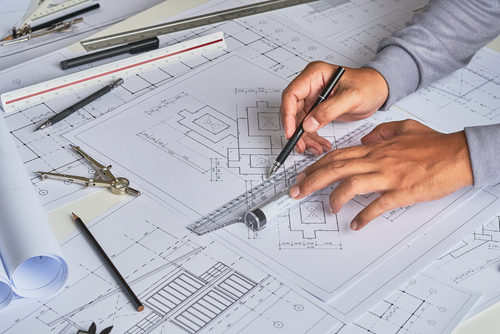The Art of Measuring: How to Choose the Right Ruler

Rulers are an office staple, but they’re much more important than many of us might think, coming in handy in art, mathematics, architecture and engineering. So in an area where precision is essential, you need the right tools for the job. Here we’ll discuss the various different types of rulers, when you may need a measuring tape instead and how to choose the right one for your job.
Are There Different Types of Rulers?

Rulers aren’t simply for drawing straight lines, they’re essential measuring tools and useful in a variety of professions, so a variety of rulers exist.
Common types of rulers include:
Straight-edge ruler - the most common type, used for measuring and drawing straight lines
Flexible ruler - similar to a straight-edge rule but made of vinyl and used for measuring irregular shapes
Architect’s scale - aka a drafting scale, used for technical drawing, architecture and engineering as it can measure to scale
Engineer’s scale - used for engineering drawings and blueprints, this has many different units of measurement
T-square ruler - used in technical drawing for drawing perpendicular lines
L-Square ruler - similar to a T-square but with a 90-degree angle, used in technical drawing for precise right-angles
Carpenter’s square - used in carpentry for measuring and drawing right angles
These rulers serve various purposes, including precise measurement for construction, technical drawing, drafting, crafting, and educational purposes. The type of ruler needed depends on the specific requirements of the task at hand.
Which Ruler Is Best?

Which ruler is best depends on what you need it for, so when looking to buy the best ruler for your precise needs, you need to consider a number of factors, including:
What type of measurement do you need (metric or imperial)?
How small a measurement do you need to take (cm or mm)?
Is precision and accuracy essential?
What is the ruler needed for?
How durable or flexible does the ruler need to be (which material is needed)?
Do you need to scale your measurements?
What size does your ruler need to be?
Do you need any additional features (non-slip/ bevelled edges, built-in protractors…)?
Ultimately, the best ruler for your needs will depend on the specific requirements of your project or task. It's essential to assess these factors and choose the ruler that provides the most accurate and efficient measurements for your particular application.
Choosing a Ruler for Architecture
Different rulers are designed for specific purposes. For example, if you're working on woodworking projects, a carpenter's square or a flexible ruler may be more suitable, but if you're doing technical drawings, an architect's scale or engineer's scale would be more appropriate.
The best ruler for architects typically depends on the specific requirements of their work, but one of the most commonly used and versatile rulers for architects is the architect's scale. Architect's scales are specially designed rulers that allow architects to make accurate scaled drawings of buildings and structures without needing to switch between rulers. Having multiple scales on one ruler streamlines the drawing process and improves efficiency.
Architect's scales are also designed for precision. The scales are carefully calibrated to ensure accurate measurements when scaling down building plans or drawings. This accuracy is crucial in architectural work where precise measurements are essential for construction and design purposes, as even the smallest miscalculation can have a huge impact.
Versatility is also key for architects, and Architect's scales can be used for various tasks, including drawing floor plans, elevations, sections, and other architectural drawings including landscape design, urban planning, and interior design projects.
Architect's scales are often made from durable materials such as plastic, aluminium, or stainless steel so they can withstand regular use in architectural offices and on construction sites, ensuring they remain reliable tools for an extended period - a key factor when choosing the right tool for the job.
Choosing a Ruler for Art

The best ruler for use in art depends largely on the type of artwork being created as well as the needs and preference of the artist. However, there are a few types of rulers that are commonly used due to their versatility, precision, and suitability for various artistic tasks.
A straight-edge ruler is a versatile tool for many art applications. It's useful for drawing straight lines, measuring, and creating precise edges in artworks such as drawings, sketches, and paintings. Straight-edge rulers come in various lengths and materials, allowing artists to choose the one that best suits their preferences and projects, so the ruler isn’t cumbersome or too short for the task.
A flexible ruler, sometimes known as a curve ruler or a French curve, is made of flexible material like plastic or vinyl, so it can be used for drawing smooth curves, arcs, and irregular shapes in illustrations, graphic designs, and fashion sketches. Flexible rulers are particularly helpful for artists working on freehand drawings or designs that require organic, flowing lines.
A T-square ruler is often used in technical drawing and drafting. While primarily used for straight lines perpendicular to the edge of the drawing board, artists may find T-squares useful for creating precise right angles and parallel lines in large-scale drawings or paintings. Triangle rulers can also be used in a similar way to draw perpendicular and angled lines, especially when creating precise geometric shapes, perspective drawings, and architectural sketches.
Ultimately, the best ruler for art depends on the specific techniques, styles, and mediums used by the artist. Artists should consider factors such as the type of lines and shapes they need to create, the size and scale of their artworks, and personal preferences for materials and handling. Often, experimenting with different types of rulers can help artists find the best tools for their artistic practice.
When to Use a Measuring Tape Instead
Measuring tapes offer several advantages over rigid rulers, but which is best for you still depends entirely on your needs.
Measuring tapes provide flexibility, bending to measure curved surfaces accurately, with markings in both imperial and metric units ensuring precise measurements and versatile use. With extended reach, they efficiently measure larger distances without repositioning, and the self-adjusting mechanisms effectively prevent the tape from tangling.
Measuring tapes also retract, ensuring ease of use and portability, while additional features like stud and centre markings enhance functionality.
Their various functions perfectly suit many applications like construction, crafting, and sewing, especially these durable fibreglass measuring tapes. But, measuring tapes offer flexibility, extended reach, ease of use, versatility, portability, and accuracy, making them indispensable tools in numerous industries and everyday tasks.
Why You Should Get a Ruler that will Help the Environment

Most companies and individuals are eager to make adjustments to help protect the environment, either by recycling old materials, or not producing more waste and harmful products. Using eco-friendly office equipment, including rulers, can have several fantastic environmental benefits, including:
Reducing the impact on the environment by using sustainable or recycled materials
Conserving energy due to easier manufacturing, causing fewer greenhouse gases
Reducing waste as items are made to be durable, requiring fewer replacements and less waste
Reducing impact of waste as many products are biodegradable or recyclable and have fewer chemicals and toxins
Showcasing a company or individual’s commitment to environmental concerns shows a social responsibility that fosters good relationship with customers and employees
Saving costs as many eco-friendly alternatives are cheaper than standard pieces of equipment
In summary, using eco-friendly office equipment, including rulers and pencils, like these treewise pencils, aligns with sustainable business practices, reduces environmental impact, promotes a fantastic relationship with customers who are equally as conscious of their environmental impact, and can result in cost savings and compliance with local business regulations.
You can make a difference by purchasing the perfect ruler from the Ruler Company Ltd, which is committed to helping the environment with its recycled plastic rulers!
The Ruler Company Ltd
At the Ruler Company Ltd, we know the importance of using the right tools for the job, whether it’s engineering, architecture, art or even any of your hobbies! Contact us today for more information on our business or our products.

